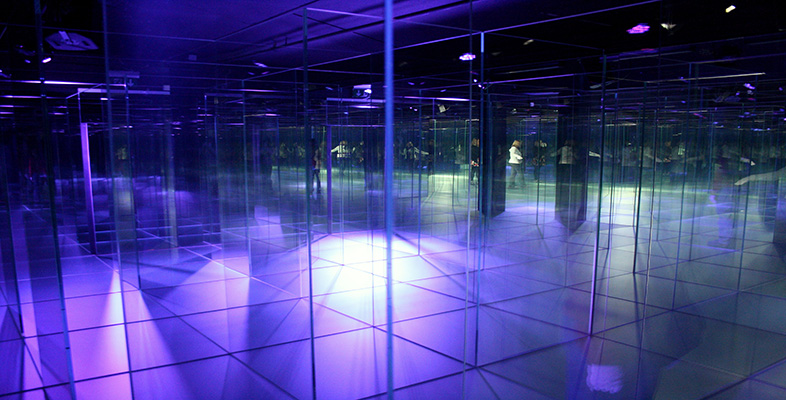3.4 Experience – making distinctions based on a tradition and constructing a history
Experience, and learning from experience, will be a major theme throughout this unit. The model of experiential learning developed by David Kolb is increasingly well known and used as a conceptual basis for the design of all sorts of processes from curricula to consultancies (Figure 32). In itself, the model is powerful but it does not address what is meant by experience or learning. In what follows, I want to provide a brief account of what these could be taken to be. My explanation is not mainstream, but arises from an appreciation of the constraints and possibilities of the observer described earlier and from the lineage labelled as second-order cybernetics in Figure 24.
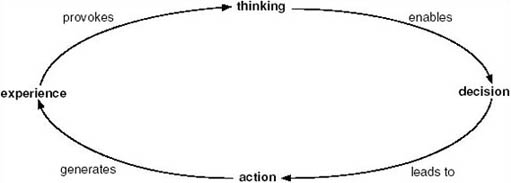
Figure 33 depicts a person (a living being) over time; as unique human beings we are part of a lineage and our history is a product of both ontogeny, which means biological growth and development, and social development. Together these form what I will call a tradition. A tradition is the history of our being in the world. Traditions are important because our models of understanding grow out of traditions. The various shapes in the clouds above the practitioner's head in Figure 33 are used to depict how our model(s) of understanding change over time. The lightbulbs depict how, over time, we can become more aware of our embodied understandings, which in turn influences systems practice.
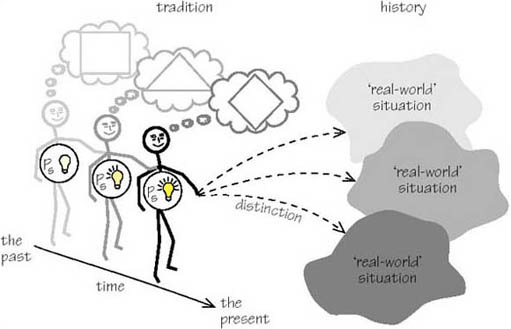
I have portrayed ‘a practitioner’ with a prior model of understanding and a current model of understanding in Figure 33. From their current model(s) – it need not be one – the systems practitioner connects with a ‘real world’ situation and makes a distinction. Based on this distinction, the practitioner can probe, or construct, the history of a situation.
Figure 33 is a refinement of the processes of being and engaging. I have now used the word tradition a number of times, including in Figure 33. I use the word in a specific way. I will call a tradition our history of making distinctions as human beings. Because experiences arise in the act of making a distinction, another way of describing a tradition is as our experiential history. To do this requires language – if we did not ‘live in’ language we would simply exist in a continuous present not ‘having experiences’. Because of language we are able to reflect on what is happening, or in other words we create an object of what is happening and name it ‘experience’.
Let me try to explain what I mean in Figure 33 by considering the main fictional character Smilla, in Peter Høeg's novel Miss Smilla's Feeling for Snow (1994). Smilla was born and spent her early years in Greenland. Her mother was an Inuit and an expert hunter. Being half Danish, Smilla subsequently pursued a Western education that built on her earlier experiences. She became an expert in the qualities of ice and snow. It was her understanding of the many different qualities of ice and snow that enabled her to solve the murder of an Inuit child around which the story is built. Her understanding also enabled her to survive in the snow and icy water when pursued by the murderers.
As an author, Høeg has grounded the distinctions Smilla is able to make about snow and ice in the history and culture of the Inuit people. Inuit culture is set against the background of continuous snow and ice. Survival depends on being able to ‘read’ the snow and ice in detail. This detail can reveal, for example, how long ago a wolf left its footprints and whether the ice will support the weight of a dog team. The distinctions the Inuit make assume their importance because of the actions they allow. They arise as embodied ways of knowing and acting in which knowledge is not separate from action. The distinctions Smilla, or other Inuit make, are not distinctions I could make except that, having read the book, I could claim to know about some of the different categories of ice and snow. But would I, in similar circumstances, be able to escape from the murderers and solve the case based on what I claim I know? The answer is no, because the distinctions Smilla makes are invisible to me; they are not part of my tradition. That would remain the case until such times as I was able to embody the distinctions about snow and ice quality and colour in my actions: for example being competent to run on snow without falling or to find the kind of snow that can be built into a shelter. From this example, the only connection I can make with my tradition is that of ‘making categories’. In contrast to Smilla, this is a rather poverty-stricken form of knowing about snow!
SAQ 6
On what does Smilla's ability to distinguish different types of snow and ice depend? What would you have to do to develop a similar skill?
Answer
Smilla's ability to distinguish different types of snow and ice depend on her history of making distinctions, which I have called a tradition; meaning a pervasive network of understanding out of which, as an individual, she thinks and acts. It comes about because she grew up with the Inuit people and was introduced and socialised into their history of making distinctions about ice and snow. To develop a similar skill you would need to immerse yourself in the context of the Inuit and to make connections with their history, which you could embody in your actions. This would not be easy and would take time, just as learning a new language takes time.
Traditions are not only ways to see and act but a way to conceal (Russell and Ison 2000a). Traditions in a culture embed what has, over time, been judged to be useful practice but there is a danger that they may become accepted practice (reified or institutionalised) in ways that no longer seem helpful. The risk for any culture is that a tradition can become a blind spot when it evolves into practice lacking any manner of critical reflection being connected to it. The effects of blind spots can be observed at the level of the individual, the group, the organisation, the nation or culture and in the metaphors and discourses in which we are immersed.
A systems practitioner always engages with the ‘real world’ situation by making distinctions which are grounded in his or her personal history of distinction-making. Based on the distinctions he or she makes, the practitioner can probe the history of the situation, much like an archaeologist, to reveal those dynamics which relate to the distinctions he or she has made. It is possible to connect with a particular history whenever we make sense of a distinction in relation to its particular historical context. For example, if you look at Figure 34 I suspect that you would have little difficulty making sense of the distinction ‘British dinosaur’ in relation to a history of symbolising British culture through the image of a bulldog and the union flag.
Because much of my practice is based in academia, and because I often encounter situations in which proposals are considered uncritically, I have found it useful to engage with the history of particular practices that impact on me. Many good insights can be found in Neil Postman's book: Technopoly. The Surrender of Culture to Technology (1993). Of the many examples he cites, I was intrigued by the history of the practice of quantifying learning, that is, giving a mark or grade for academic work. Today it seems so much part of our daily life we do not question it. Yet prior to 1792, when it was first carried out at the University of Cambridge this was an unknown practice. Interestingly it was fostered mainly by military colleges.
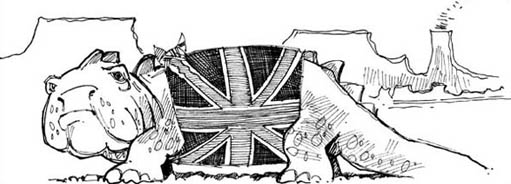
I call practices such as grading and examining, which become unquestioningly incorporated into a culture, social technologies – this is also what I mean by a practice becoming reified. All explanations also have a history, something which has become more apparent in recent years with the emergence of new academic disciplines in the history and sociology of science and technology. Explanations are also open to historical (re)interpretation.
So, after reading Peter Høeg's novel I can claim that I know about the different categories of snow by listing them. Perhaps after visiting Greenland with an Inuit guide I could claim that I know the different kinds of snow if I can distinguish them successfully. To claim I understand them would require me to be able to explain how, when and where different kinds are formed or found, and what implications they have for various activities, my own and other animals. In this latter two cases I need to ground the categories or distinctions within the historical context of the Inuit, much as I have tried to do in my brief description above. However I would need to do much more to embody these distinctions in my practices in the snow, that is to know, or practice in, snow. To know snow I would need to be able to claim that I have embedded my distinctions in a tradition – my own network of pre-understandings out of which I think and act. A test would be that under similar circumstances to Smilla my behaviour had similar results.
Of course, sometimes traditions collide!
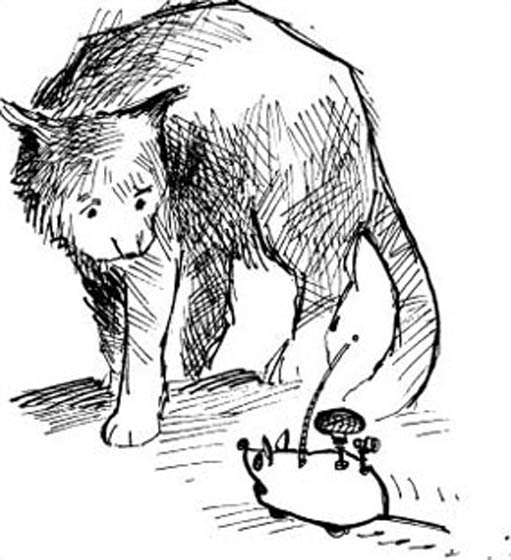
Activity 39
Connecting with a history in your own context.
At the beginning of this part of the unit, I invited you to consider one of your own role(s) and situation(s) that could be kept in mind as you worked through Part 3. With this in mind, are you able to think of a practice that is carried out unquestioningly? Are you able to engage in any elementary archaeology to uncover some of the history of this practice? Do try this activity but do not worry if you are unable to identify one.
Answer
Quantifying assessment arose as a practice in the 18th century. An example is the following which has been doing the rounds as an email joke: perhaps you have seen it before but not considered it in the light of my explanation?
Horse's Ass
The US Standard railroad gauge (distance between the rails) is 4 feet, 8.5 inches. That's an exceedingly odd number. Why was that gauge used? Because that's the way they built them in England, and the US railroads were built by English expatriates.
Why did the English people build them like that? Because the first rail lines were built by the same people who built the pre-railroad tramways, and that's the gauge they used.
Why did ‘they’ use that gauge then? Because the people who built the tramways used the same jigs and tools that they used for building wagons, which used that wheel spacing.
Okay! Why did the wagons use that odd wheel spacing? Well, if they tried to use any other spacing the wagons would break on some of the old, long distance roads, because that's the spacing of the old wheel ruts.
So who built these old rutted roads? The first long distance roads in Europe were built by Imperial Rome for the benefit of their legions. The roads have been used ever since. And the ruts? The initial ruts, which everyone else had to match for fear of destroying their wagons, were first made by Roman war chariots. Since the chariots were made for or by Imperial Rome they were all alike in the matter of wheel spacing.
Thus, we have the answer to the original questions. The United States standard railroad gauge of 4 feet, 8.5 inches derives from the original specification (military specification) for an Imperial Roman army war chariot. Military specifications and bureaucracies live forever. So, the next time you are handed a specification and wonder what horse's ass came up with it, you may be exactly right. Because the Imperial Roman chariots were made to be just wide enough to accommodate the back-ends of two war horses.
